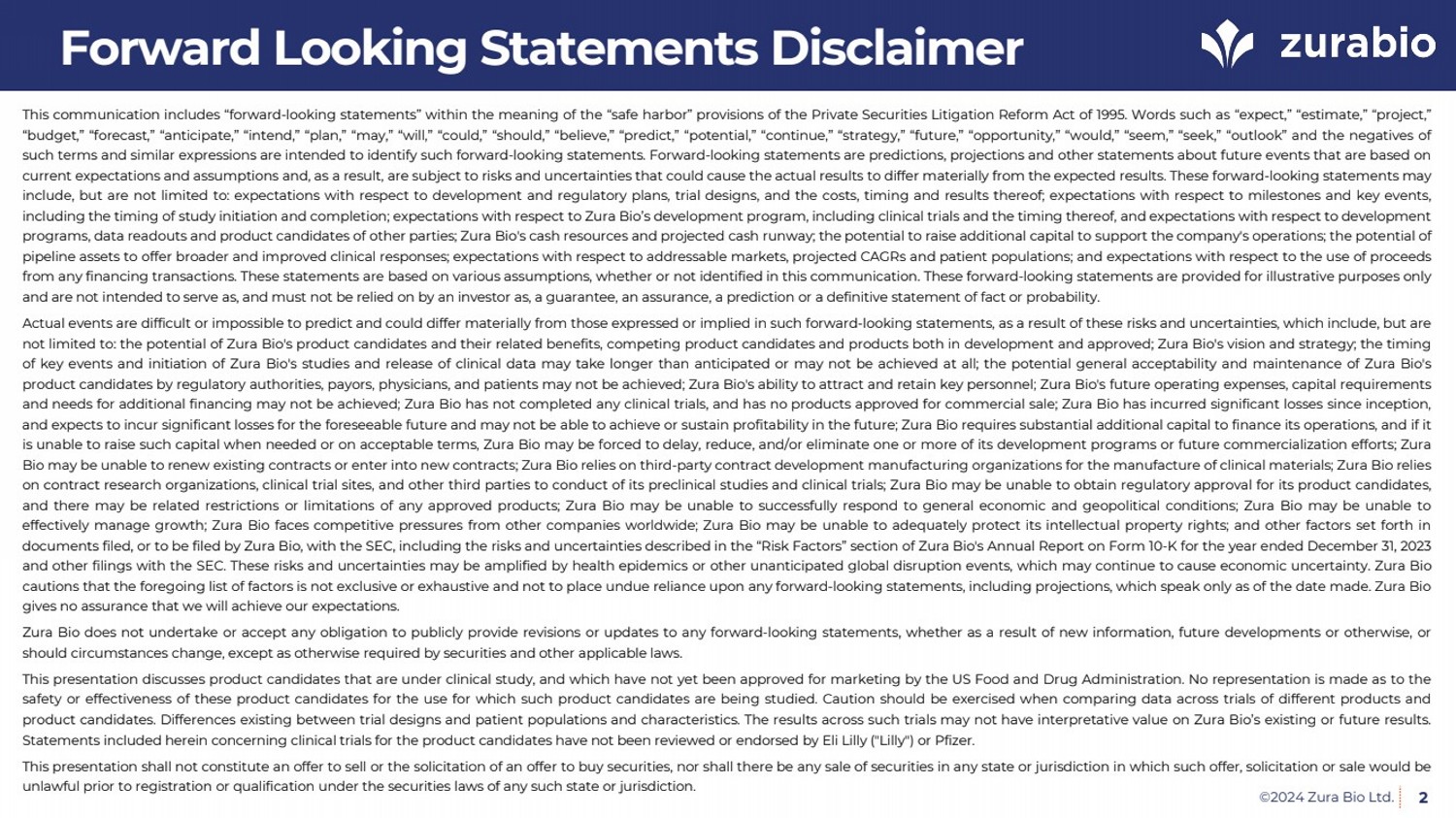
| ©2024 Zura Bio Ltd. 2
Forward Looking Statements Disclaimer
This communication includes “forward-looking statements” within the meaning of the “safe harbor” provisions of the Private Securities Litigation Reform Act of 1995. Words such as “expect,” “estimate,” “project,”
“budget,” “forecast,” “anticipate,” “intend,” “plan,” “may,” “will,” “could,” “should,” “believe,” “predict,” “potential,” “continue,” “strategy,” “future,” “opportunity,” “would,” “seem,” “seek,” “outlook” and the negatives of
such terms and similar expressions are intended to identify such forward-looking statements. Forward-looking statements are predictions, projections and other statements about future events that are based on
current expectations and assumptions and, as a result, are subject to risks and uncertainties that could cause the actual results to differ materially from the expected results. These forward-looking statements may
include, but are not limited to: expectations with respect to development and regulatory plans, trial designs, and the costs, timing and results thereof; expectations with respect to milestones and key events,
including the timing of study initiation and completion; expectations with respect to Zura Bio’s development program, including clinical trials and the timing thereof, and expectations with respect to development
programs, data readouts and product candidates of other parties; Zura Bio's cash resources and projected cash runway; the potential to raise additional capital to support the company's operations; the potential of
pipeline assets to offer broader and improved clinical responses; expectations with respect to addressable markets, projected CAGRs and patient populations; and expectations with respect to the use of proceeds
from any financing transactions. These statements are based on various assumptions, whether or not identified in this communication. These forward-looking statements are provided for illustrative purposes only
and are not intended to serve as, and must not be relied on by an investor as, a guarantee, an assurance, a prediction or a definitive statement of fact or probability.
Actual events are difficult or impossible to predict and could differ materially from those expressed or implied in such forward-looking statements, as a result of these risks and uncertainties, which include, but are
not limited to: the potential of Zura Bio's product candidates and their related benefits, competing product candidates and products both in development and approved; Zura Bio's vision and strategy; the timing
of key events and initiation of Zura Bio's studies and release of clinical data may take longer than anticipated or may not be achieved at all; the potential general acceptability and maintenance of Zura Bio's
product candidates by regulatory authorities, payors, physicians, and patients may not be achieved; Zura Bio's ability to attract and retain key personnel; Zura Bio's future operating expenses, capital requirements
and needs for additional financing may not be achieved; Zura Bio has not completed any clinical trials, and has no products approved for commercial sale; Zura Bio has incurred significant losses since inception,
and expects to incur significant losses for the foreseeable future and may not be able to achieve or sustain profitability in the future; Zura Bio requires substantial additional capital to finance its operations, and if it
is unable to raise such capital when needed or on acceptable terms, Zura Bio may be forced to delay, reduce, and/or eliminate one or more of its development programs or future commercialization efforts; Zura
Bio may be unable to renew existing contracts or enter into new contracts; Zura Bio relies on third-party contract development manufacturing organizations for the manufacture of clinical materials; Zura Bio relies
on contract research organizations, clinical trial sites, and other third parties to conduct of its preclinical studies and clinical trials; Zura Bio may be unable to obtain regulatory approval for its product candidates,
and there may be related restrictions or limitations of any approved products; Zura Bio may be unable to successfully respond to general economic and geopolitical conditions; Zura Bio may be unable to
effectively manage growth; Zura Bio faces competitive pressures from other companies worldwide; Zura Bio may be unable to adequately protect its intellectual property rights; and other factors set forth in
documents filed, or to be filed by Zura Bio, with the SEC, including the risks and uncertainties described in the “Risk Factors” section of Zura Bio's Annual Report on Form 10-K for the year ended December 31, 2023
and other filings with the SEC. These risks and uncertainties may be amplified by health epidemics or other unanticipated global disruption events, which may continue to cause economic uncertainty. Zura Bio
cautions that the foregoing list of factors is not exclusive or exhaustive and not to place undue reliance upon any forward-looking statements, including projections, which speak only as of the date made. Zura Bio
gives no assurance that we will achieve our expectations.
Zura Bio does not undertake or accept any obligation to publicly provide revisions or updates to any forward-looking statements, whether as a result of new information, future developments or otherwise, or
should circumstances change, except as otherwise required by securities and other applicable laws.
This presentation discusses product candidates that are under clinical study, and which have not yet been approved for marketing by the US Food and Drug Administration. No representation is made as to the
safety or effectiveness of these product candidates for the use for which such product candidates are being studied. Caution should be exercised when comparing data across trials of different products and
product candidates. Differences existing between trial designs and patient populations and characteristics. The results across such trials may not have interpretative value on Zura Bio’s existing or future results.
Statements included herein concerning clinical trials for the product candidates have not been reviewed or endorsed by Eli Lilly ("Lilly") or Pfizer.
This presentation shall not constitute an offer to sell or the solicitation of an offer to buy securities, nor shall there be any sale of securities in any state or jurisdiction in which such offer, solicitation or sale would be
unlawful prior to registration or qualification under the securities laws of any such state or jurisdiction. |